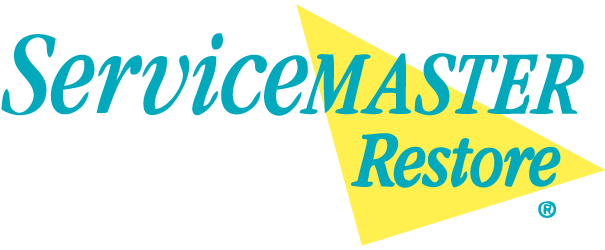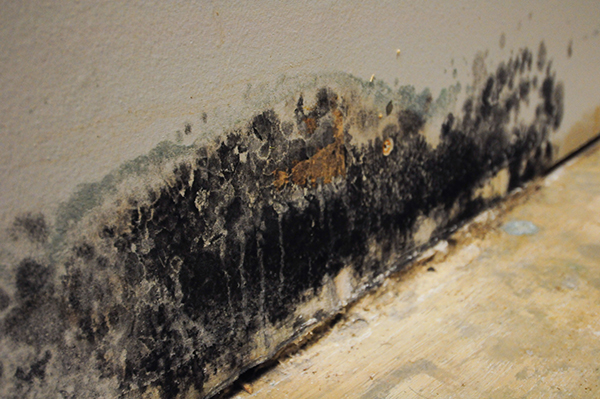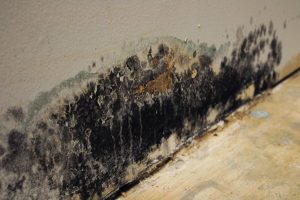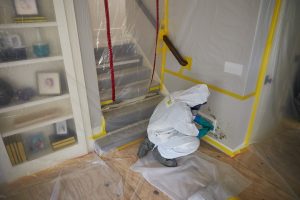No one wants to deal with mold growth in their home or building, but it doesn’t take much for such a problem to occur. With the prevalence of water damage and the natural presence of mold spores, mold growth can easily affect your residential property.
Oftentimes, the walls are a common place for mold to grow. Mold needs moisture and an organic food source to form colonies and mold uses cellulose found in drywall as a food source. The mold growth will eat away at the material and will eventually cause structural harm. In addition to the structural damage caused by mold, it can be a danger to your health.
If you find mold on the walls of your property, then do not hesitate to act. Use the following tips to help deal with the problem.
Signs of Mold on Walls Stains and Discoloration
When mold is growing on walls, there are often visible signs such as staining and discoloration.
Mold itself can appear in various colors. Black is a common color of mold, but the fungus can also appear brown, green, gray, orange, purple, or pink. The shade can differ depending on whether the wall is exposed, simply painted, or has been covered in wallpaper.
When mold has affected walls, it can also show signs of staining. This is because water damage is often a precursor to mold growth. So if mold has grown on a wall, then the affected wall may have yellow or brown water stains.
Textural Changes
Mold growth can also cause walls to experience changes in the material’s surface. The paint or wallpaper covering the wall might be found peeling off, cracking, or bubbling as a result of moisture and the mold. In severe situations, the wall can have bulges.
Musty Odor
Mold gives off a musty smell, so encountering such a smell can be an indicator of an issue. This can be an especially helpful tidbit to know if the mold growing in your home has yet to make itself visible.
Mold Removal
Once you spot mold on your walls, act right away to prevent further damage. The longer that mold growth goes untreated, the worse it will become. If the mold hasn’t affected too much of your wall, then you can try to remove the mold yourself.
Removing Mold from Drywall
If the mold has affected pure drywall that has not been covered with paint or wallpaper, then you will need to replace the damaged part of the drywall. The drywall is porous and is likely beyond salvaging because of the way the mold has worked its way into the material’s structure.
To do this, you will need a new sheet of drywall and plastic coverings to protect surrounding areas. Cut out a section from the new drywall that is bigger than you need. Then carefully cut out and remove the mold-damaged drywall. Keep the moldy side up when you place it down on the plastic.
From there, size down the new drywall piece to properly fit it into the missing part. Use mold-resistant paint on the wall cavity and new drywall.
Make sure to clean the area with a HEPA vacuum to ensure lingering mold spores are eliminated.
Removing Mold from Painted Walls
If the mold has affected painted walls, then prompt action can prevent the fungus from affecting the wall’s structure. For the time being, the mold spores are just on the wall’s surface but can still spread, so waiting to act is not advised.
Clear the area as much as you can and use plastic coverings to protect nearby items and furnishings. First, clean dirt and debris from the wall with dish soap and warm water. Then, scrub the area with a natural cleaning solution of warm water, white vinegar, and (if desired) borax. Rinse it off and pat the wall dry.
If this natural method isn’t sufficient, then try a stronger method of a commercial mold cleaner. Alternatively, you can create a solution that is three parts water and one part bleach. Apply the cleaner to the affected area and allow 10 minutes of sitting time before using a brush to thoroughly scrub the wall. Then, use a clean cloth to dry the area.
As is the case with unpainted drywall, consider painting over the area with mold-resistant paint.
Professional Mold Remediation Services
While there are do-it-yourself methods you can use for mold removal, handling such a task on your own is often not a good idea. Improper mold removal methods can worsen the problem, and it also exposes you further to the fungus. Given the negative health effects mold can cause, it is best to avoid DIY techniques and instead seek professional mold remediation help.
If you encounter mold on the walls of your home, then ServiceMaster S&R Systems can help through the professional mold remediation services we provide in Joliet, IL, and the neighboring areas. Our professional technicians will assess the mold growth, develop a proper mold remediation plan, and isolate the affected areas for mold control purposes. From there, we will remove the mold in a safe and effective manner. Following mold removal, we then clean and restore damaged items.
Reach out to us for mold remediation help, and your property will be clean, safe, and free of mold once again.



